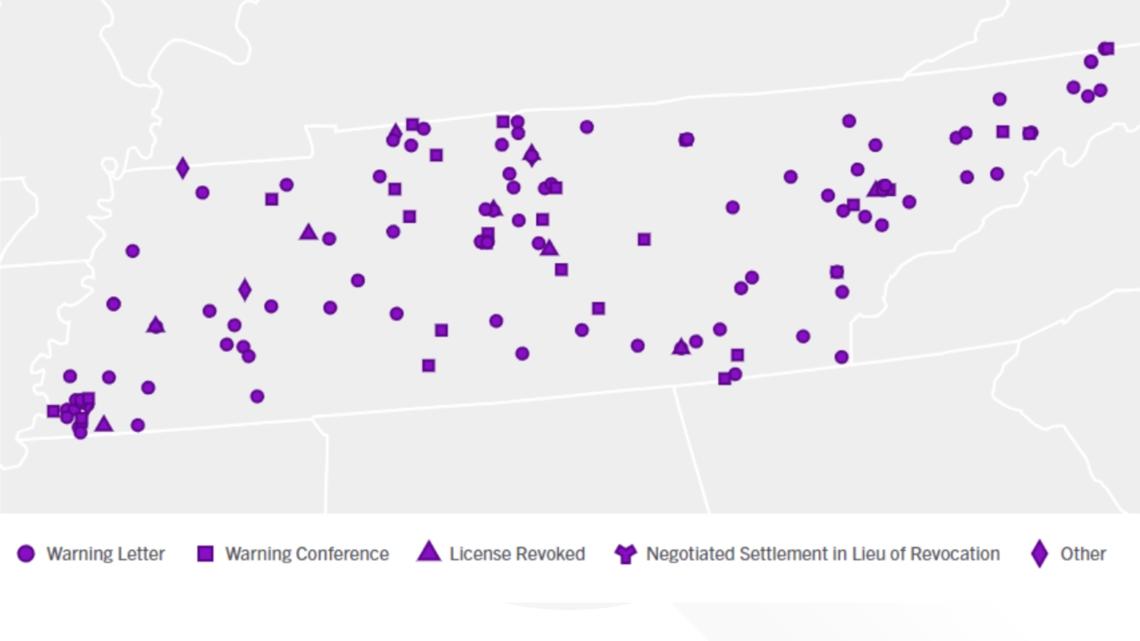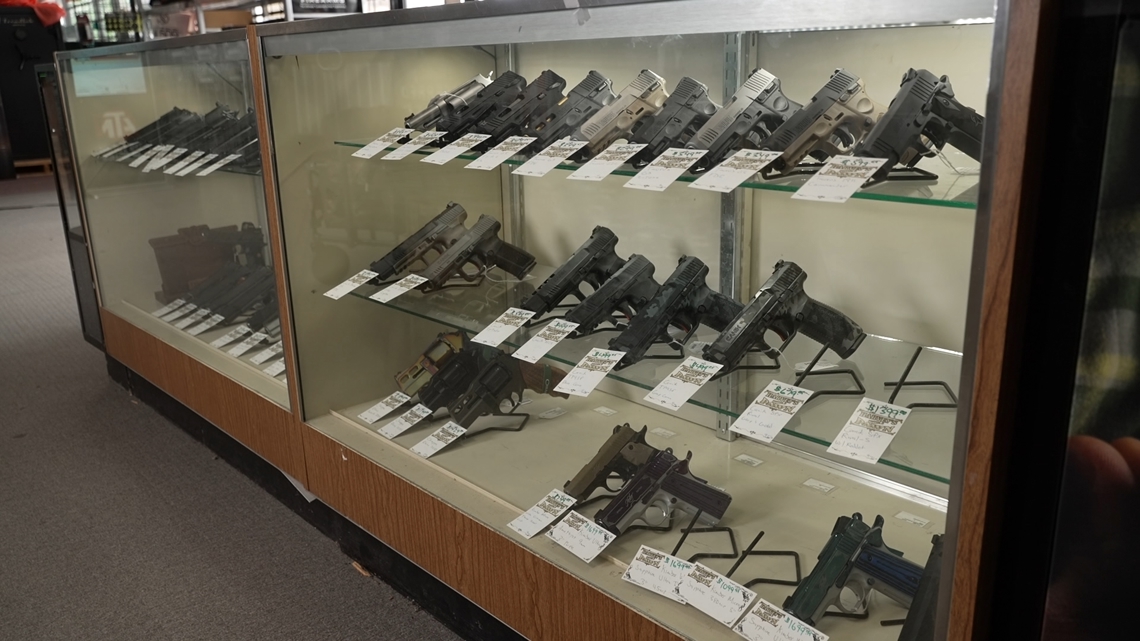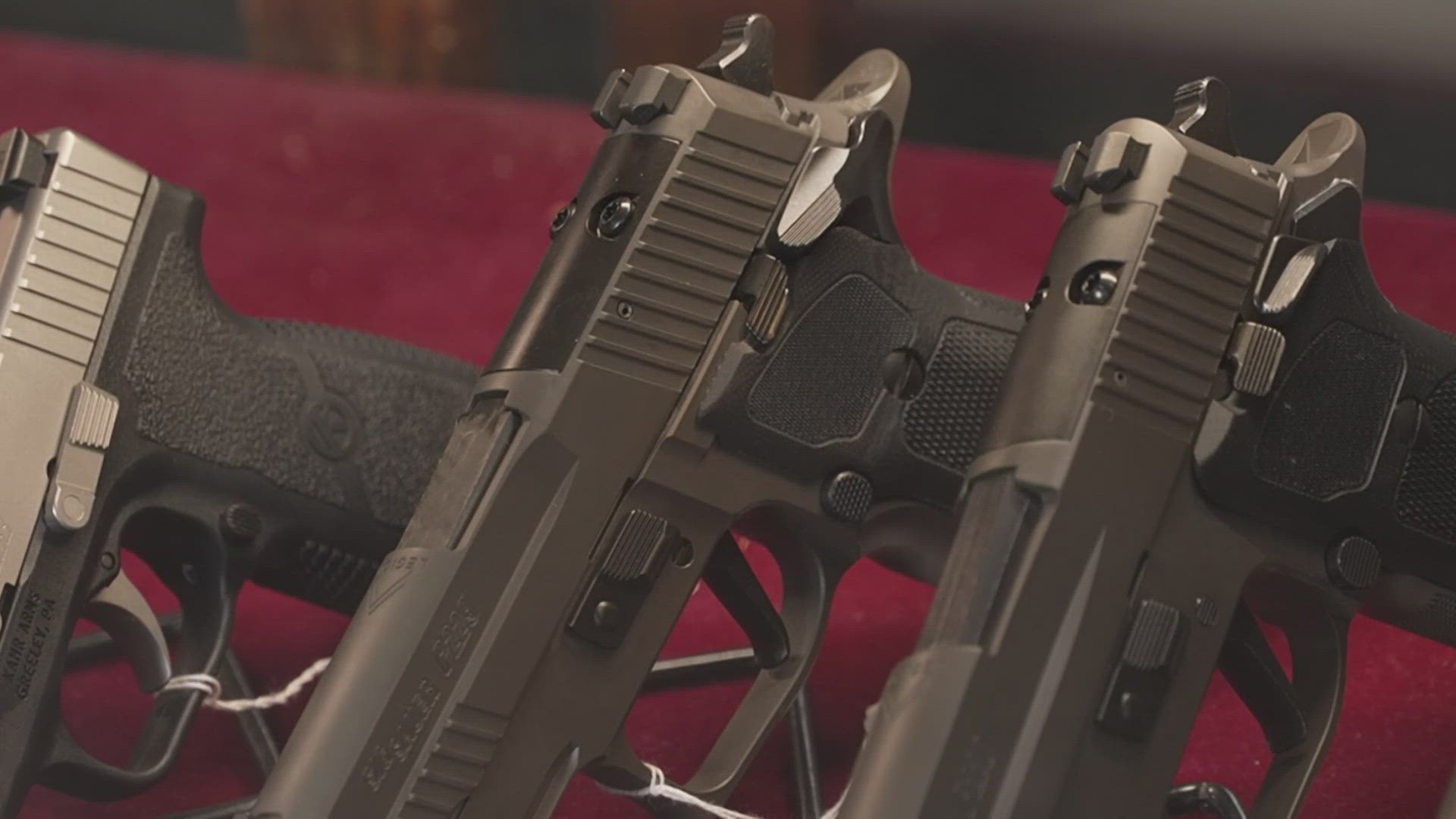KNOXVILLE, Tenn. — The federal government launched a program designed to “disrupt the flow of illegal firearms through identified trafficking channels,” said representatives of the Bureau of Alcohol, Tobacco, Firearms and Explosives in a written statement to 10News. The Demand Letter 2 program targets certain firearms sellers including eight in the Knoxville area.
They received written warnings about reaching what the government considers a notable threshold, “25 or more firearms traced to them in the previous calendar year with a “time-to-crime” (TTC) calculation of three years or less.”
One Knoxville business on the list of more than 1,500 across the country in 2023 is Harvey’s Pistol and Pawn.
“For the most part, dealers that have a large volume and sales. And therefore, if there's going to be crime, we're probably going to have sold the gun. For many, many of the businesses on that list, the Bass Pro, the Cabela's — very large companies. We're one small business, but we still sell a pretty high volume of firearms,” said John David Whitehead owner of the store.
However, advocates for gun violence said the list helps identify stores that may need to improve the ways they do business.
“This list alone provides notice to gun dealers that are selling large quantities of crime guns with short time-to-crimes that they are among less than 2% of dealers that are selling in those types of quantities. And it provides the notice that for whatever reason, gun traffickers, and straw purchasers are targeting their stores,” said Josh Scharff, general counsel and senior director of programs at Brady, a nonprofit devoted to ending gun violence across the U.S.


That’s a glimpse of the debate and discussion surrounding the federal program and its merits. What follows are individual perspectives. The questions and answers are edited for space and clarity.
The Gun Shop
In our interview with Whitehead, we learned his take on the federal program and the impact of appearing on the list for the first time in 2020.
What are the impacts of appearing on the list?
“It’s a little more work. But, just have to report that quarterly.”
Does it hurt business? Or does it help business?
“Our customers don't know anything about it. So it's just a little more work for us, you know. So it's, it's, if anything, it's really people that are selling a lot of firearms, went up on that list is what I find.”
“For the most part, it's with us dealers that have a large volume and sales, and therefore, if there's going to be crime, which is certainly obvious, we're probably going to have sold the gun. For many, many, many of the businesses on that list.”


“It doesn't even indicate that we sold it to someone who later committed a crime, if I sell a firearm, and then that person well within their rights, sells the firearm privately, and then that happens another time or two down the line. And then it gets found at a traffic stop, or heaven forbid, a much more serious crime, it doesn't indicate that I sold the firearm to anyone that shouldn't have had it. That's a very likely scenario as well. And when you sell the volume of firearms that we do that's bound to happen.”
It appears to be an effort to seek out “straw purchasers,” people buying a gun for someone else, which is a felony?
“It's designed to do that, I'm not sure if it's extremely effective. It may have been the intent, but I don't know. And again, I'm not on the law enforcement side of this, but, that list doesn't affect how we scrutinize our customers.”
“I think anyone that's using this list to form an opinion about firearm dealers just has to know that that it's — I find it to be entirely volume related, almost entirely volume related. If you sell a large number of firearms, they're going to circulate through the public. And when something bad happens with one, it's going to get traced back to the guy who sold it first.”
The Brady Campaign
In our interview with Scharff, general counsel and senior director of programs at Brady, he outlined why they petitioned the government to make this list public. But, we started the conversation with why Brady thinks it should serve as a warning to gun sellers on the list.
“A responsible gun dealer would take a look at its inclusion on this list and say, 'How can I do better?' How can I sell fewer guns? The overwhelming majority of gun dealers in this country are responsible gun sellers that do not want to harm the public's safety, and they adopt reasonable business practices in order to meet that goal. And inclusion on this list should cause responsible dealers to look at their own business practices to see how they can improve. And that is a positive impact on our society and on the public health of the American, of our nation.”
What changes should gun sellers be imploring in their business practices?
“We encourage, first, all gun dealers and the American public to take a look at our model gun dealer Code of Conduct. It lists a variety of responsible business practices, some that are mandated in certain states by law, many that are just adopted by responsible gun dealers on their own. And that includes street screening for straw purchasing, really knowing your customer, identifying patterns of potentially risky sales, ensuring that the name on the method of payment matches the name of the individual that you're running the background check on having an appropriate security in the in the store in order to prevent theft. Again, these are reasonable business practices that go a long way. And importantly, they're backed by research. They're backed by analysis.”
Why did you push to make the ATF list public?
“When that information was available at the national level, 20 years ago, we learned that only 5% of gun dealers were responsible for transferring 90% of guns that were recovered in crime — a very small percentage of dealers for a very large amount, the overwhelming majority, of guns recovered in crime. This information, the gun industry, the gun manufacturers, did not like it being out in public. And they passed something called the Tiahart Amendment in order to hide that information from the American public and keep researchers and journalists and the American public in the dark. We identified that the Demand Letter 2 program was a way to get some of this information — not all of this information, but some of this information in a way that did not run afoul of the Tiahart Amendment. We strongly advocate for trace data itself to be public, again for Congress to pass a law to allow the American people to see this information."
Bureau of Alcohol, Tobacco, Firearms and Explosives
Why is the ATF collecting this information?
"Each calendar year, ATF personnel review the previous year's trace data to determine which Federal Firearms Licensees (FFLs) will be required to participate in the Demand Letter 2 program. Based upon this data review, Demand 2 letters are sent to FFLs who had 25 or more firearms traced to them in the previous calendar year with a 'time-to-crime' calculation of three years or less. In CY-2023, a total of 1,324 FFLs met this threshold and were issued a letter mandating participation in the Demand Letter 2 program.
Crime gun traces that involve a short TTC, generally considered a trace occurring within three years or less, are often an indicator of illegal firearm trafficking. See, National Firearms Commerce and Trafficking Assessment (NFCTA): Crime Guns Volume Two, (Data about firearms with a short time-to-crime can reveal “significant trafficking trends and patterns in recently transferred firearms. Investigating crime guns with a short TTC allows law enforcement to seek out sources of recently transferred crime guns and disrupt the flow of illegal firearms through identified trafficking channels.” NFCTA, Volume Two, Part III at page 23.)
By focusing on frequency of crime gun traces with a relatively short-TTC, the Demand Letter 2 program provides ATF with additional data about source locations for crime guns. This does not mean, however, that the FFLs subject to Demand Letter 2 – or involved with other traces – have engaged in any form of wrongdoing. A number of factors, including geography, sales volume, secondary market transfers by an original lawful purchaser, and the level of sophistication of firearm traffickers, may be involved in a traced crime gun.
The Demand Letter 2 program also enhances public safety by better enabling ATF to trace used firearms that have been resold by an FFL involved in the program. Additionally, used firearm information received because of the Demand Letter 2 program enables ATF to trace used firearms sold by those FFLs. Without this information, ATF is often unable to link the secondary market (“used”) firearms to the dealer."
What do you hope gun dealers do with this information?
"The Demand Letter 2 program helps raise awareness among participating FFLs that their businesses may be susceptible to trafficking schemes as a possible result of the aforementioned factors. It is important to note that following the submission of an initial Demand Letter 2 report, participating FFLs are required to continue submitting Demand Letter 2 reports on a quarterly basis until informed otherwise by ATF. FFLs are notified that they have been removed from the Demand Letter 2 program the following year if they no longer meet the criteria when the annual report is generated."
What responsibility do gun dealers bear for ensuring the guns they sell aren’t used in a crime?
"Among other things, federally licensed firearms (FFLs) dealers are required to run background checks, maintain records, and respond to ATF requests for records during the crime gun tracing process. To assist FFLs in complying with these requirements and provide them with additional information on detecting and preventing the unlawful diversion of firearms, ATF has published the Federal Firearms Licensee Quick Reference and Best Practices Guide:
ATF also provides outreach programs and provides guidance in response to specific questions FFLs may have pertaining to compliance with federal regulations, steps they can take secure inventory, and practices that help prevent the transfer of firearms to prohibited persons."
Can you offer context on factors like geography and sales volume that could factor into appearing on the list?
"Geographic location and sales volume are often inter-related factors that can influence the number of trace requests an FFL receives. FFLs located in close proximity to large population centers, such as major cities, tend to have higher sales volume than FFLs located in areas with lower population density. Moreover, larger cities also generate a substantial number of the trace requests ATF receives annually, influencing the statistical probability that FFLs who conduct business near those centers will receive a trace request. The linkage between larger cities and traces is documented in the NFCTA, Volume II, Part III:
'Between 2017 and 2021, large population among cities with populations of 1,000,000 residents or greater (‘mega cities’), Chicago had the largest number of crime gun traces (50,312) followed by Houston, Los Angeles, Philadelphia, and Dallas (Table OFT-02a). Detroit submitted the largest number of crime gun traces (26,065) among cities with populations of 500,000 to 999,999 residents (‘large cities’). Atlanta had the largest number of crime gun traces (15,333) among cities with populations of 250,000 to 499,999 residents (‘medium cities’). Baton Rouge had the largest number of crime gun traces (8,544) among cities with populations of 100,000 to 249,999 residents (‘small cities’).'
As a matter of simple statistics, FFLs with higher sales volumes tend to receive more trace requests than those with lower sales volume, including trace requests involving a short TTC (3 years or less). Because the Demand 2 Letter program is based upon firearm trace counts of at least 25 or more traces with a short TTC, high-volume FFLs, including those located in or near densely populated areas, are more likely than FFLs with lower sales volume to be included in the program. Again, this does not mean, that the FFLs subject to Demand Letter 2 – or involved with other traces – have engaged in any form of wrongdoing."

